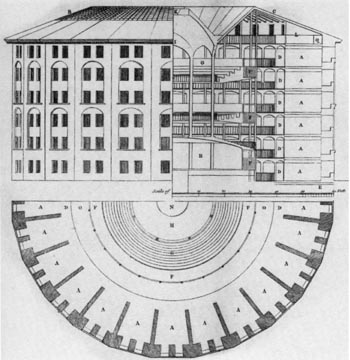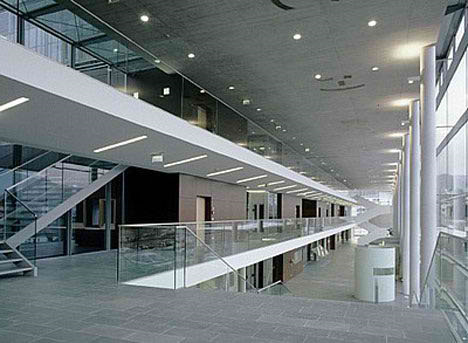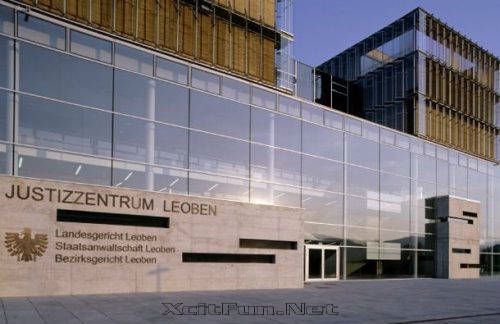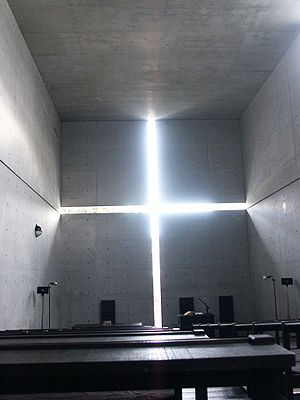Philip Johnson once said: “All architecture is shelter, all great architecture is the design of space that contains, cuddles, exalts, or stimulates the persons in that space” (Brainy Quote). Moreover, we can say that architecture was always considered to be not only art able to satisfy the primary human needs in the shelter, housing, etc. but also it contained and conveyed more philosophical ideas and thoughts which could be implied only in architectural works.
This essay is devoted to the discussion of Hirst’s analysis of architecture and power, specifically the scopic regime inherent in the panopticon and other modern buildings. There are two important questions to be answered in our research:
- Is this form of instrumental function is avoidable in modern architecture?
- What is the relationship between ascribing a building with specific functions and the building taking on the role of enforcing behavior appropriate to those functions?
The definition of the scopic regime is properly highlighted in the article Incarnate Word: Verbal Image, Body Image, and the Rhetorical Authority of Saint Catherine of Siena, where Kristine Fleckenstein points out: “scopic regime is the tacit cultural rules of differing times, places, and people that enable a community to see some things and not others” (Fleckenstein). Thus we see that a scopic regime is a complex method consisting of several components that define what we see and how we see it. According to this theory scopic regime may be determined as “the distinct manifestations of visual experience in all its possible modes” (Fleckenstein).
Several types of research provide evidence that scopic regime is inherent in the panopticon. The critic work Foucault and Architecture by Hirst properly illustrates this position. Hirst says that Foucault presents rather a new conception of “disciplinary power”. The notion of disciplinary power implies “surveillance” of subjects. In other words, it is a critical mode that allows transforming things especially archeological artifacts. Surveillance in architecture needs knowledge as well as institutions required by knowledge for its proper functioning.
Thus, we can say that Foucault’s approach to architecture and his theory about disciplinary power discussed by Hirst has similar traits of the conception of contradictions between power and knowledge, power and truth. There is evidence that power plays a role in enforcing behavior appropriate to particular functions.
According to Hirst’s criticism, the control in prison is fulfilled not only by the isolation and specification of individuals but also by means of the transformation or construction of subjects. This unique theory is effectively put into practice. Prisoners are isolated from one another and from the non-criminal society. Their behavior and actions are properly inspected and subordinated to norms of performance. This process was determined by Foucault as “normatising individuation”.
Hirst also points out that “the archetypal form of such a prison as a system of power based on surveillance, where individuals are brought under what Foucault calls the “eye” of power is to be found in the English social reformer Jeremy Bentham’s proposal for a panoptical prison” (Hirst 1984, p.17).
Figure 1 below presents the model of the famous prison. The structure of the building is a complex scheme. The floors of the prison are filled with numeral cells which excludes the possibility of prisoners having any contact with each other. In the mean time the special inspection tower located in the centre of the building allows to observe every person in jail. Rather interesting is the light principle. Light comes inside in such a way that prisoners can be surveyed without knowing about it. There is a clear confirmation of a scopic regime in this evidence. The definition of Fleckenstein about is as a complex method of what we see and how we see it is applied in panopticon appropriately.

On the example of Panopticon we can observe the direct relationship between ascribing a building with specific functions and the building taking on the role of enforcing behavior appropriate to those functions. In a work of Hirst we find words that serve to confirm our opinion.
According to Hirst’s criticism, Bentham outlined the Panopticon to be the new concept in architecture. The main principle that makes this building to be distinguished among the others eminent constructions is that the many people can be governed only by a few persons. The Panopticon is not a simple prison from the point of view of architecture. It is a complex construction and a “statement” made through the construction. Its wide space and special form of multilevel building present a machine of productive power. The stare of the inspector in the central part of prison is a kind of power-knowledge. It is able to control the conduct of the prisoners. At the same time, it re-models their conduct according to the inside functions and orders.
However, the relationship between ascribing a building with specific functions and the building taking on the role of enforcing behavior appropriate to those functions can be presented in a different way even in similar architectural artifacts. Justizzentrum Leoben is such an example.
Justizzentrum Leoben is a luxury court and prison complex in Austria. It was designed by architect Joseph Hohensinn. The building was completed in November 2004. Though its primary function is to punish prisoners according to the level of their criminal actions and delinquencies, the conception of disciplinary power depicted by Hirst is presented here in a different way. If to compare this prison with Panopticon one can see a great difference. Prisoners in Justizzentrum Leoben are not isolated from each other and from society. Moreover, their living conditions are almost luxurious: separate rooms with TV sets, gym, various entertainment, etc. Disciplinary power is implied not through the total control of the conduct but through moral re-modeling. Two inscriptions on the prison’s walls illustrate this approach: “all human beings are born free and equal in dignity and rights,” and “each of the persons deprived of their liberty must be humanely and with respect for the inherent dignity of the human being treated.” The function of the building is more psychological than physical. And figure 2 properly illustrates this idea.


We must say that this form of instrumental function is not avoidable in modern architecture. It is present not only in prisons but in other public buildings. Church of the Light by Tadao Ando is a real masterpiece of functional architecture.
Church of the Light by Tadao Ando presents a rectangular volume building. The almost freestanding wall separates this construction at a 15-degree angle. Sunlight penetrates the dark space through the huge cross made into the altar wall. The floor made of wood is also lightened from the outside. A big cross on the floor formed by the cross made in the wall adds impressions and deepens the primary functions of the church.
Figure 3 illustrates the special relationships of humans and divine nature. Moreover, it proves that instrumental function is not avoidable even in modern architecture. Speaking the simple words, the design of the church cannot avoid the power. But it always provides people a “disciplinary power”.
The space of openings in the church is rather limited. It allows intensifying the little sunlight inside the building. Though the brilliant cross can be observed only against a backdrop of darkness, its architectural function contains less importance than the moral and spiritual one. Another cross reflected on the floor increases such function and expresses pure spiritual relationships of human beings with nature.
In the work, Church of the Light Crosbie notices that “Ando believes that the architecture grows continually purer” (Crosbie2006, p. 34). Disciplinary power consists in creating special divine nature inside the church. Cross made of light on the background of dark wall symbolizes salvation which can be received through repentance and acceptance of a new lifestyle and mode of thinking. The influence of church is evident. Its role of enforcing behavior appropriate to appropriate functions can be seen on the level of subconsciousness.

Tadao Ando’s another creation Church on the Water is one more example that proves that the form of instrumental function is not avoidable in modern architecture. Though it was roughly criticized in international press for the new approach to the architecture, the relationships between ascribing a building and its functions are properly conveyed in this construction.
Figure 4 illustrating the Church on the Water outlines the nature possessing the active force. The sanctuary presents an open-ended building overcome by a beautiful artificial pool that looks like a pond. The only wall that separates interior and exterior worlds is made of glass. Thus, it erases the visible boundaries between human and nature, terrestrial and divine. This is the main function of the church, to make people feel themselves integral part of the world and not only consumers of its goods. The idea about altar deepens the sense of special connectedness with the world that reflects in calm water in the pond.

In conclusion I would like to say that Hirst’s criticism of Foucault’s approach to the architecture casts light on some points. It presents rather new conception of architecture. Hirst study is directed to give the more profound vision of architecture artifacts functions. The central concept of the relationship between ascribing a building with specific functions and the building taking on the role of enforcing behaviour appropriate to those functions is conveyed in modern buildings. Panopticon and Justizzentrum in Leoben are distinguished examples that emphasize those relationships and illustrates what a “disciplinary power” is and what role does it play in architecture. At the mean time they present clear evidence that disciplinary power can be presented in the different aspects even in tow similar buildings. The incontestable evidence that the concept of “disciplinary power” and the form of instrumental function criticized by Hirst is not avoidable even in modern architecture is not only a theory on the paper but the functional ideas successfully put into practice. The Church of Light and the Church on the Water are the unique phenomena in architecture that clarified the question to be answered and presented more profound understanding and convey the principles of architecture from the radically new position.
Reference List
Bentham J 1843, The Works of Jeremy Bentham vol.IV, pp. 172-173. W. Tait Brainy Quote, 2010. Web.
Crosbie, MJ 2006, Houses of God: Religious Architecture for a New Millennium, Images Publishing.
Fleckenstein, K 2009, Incarnate Word: Verbal Image, Body Image, and the Rhetorical Authority of Saint Catherine of Siena, Enculturation, a Journal of Rhetoric, Writing, and Culture. Web.
Hirst, PQ 1984, Foucault and Architecture, Local Consumption Publication.